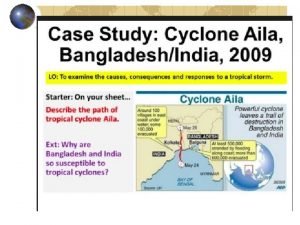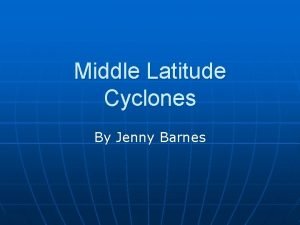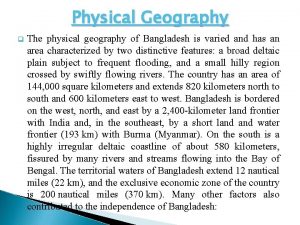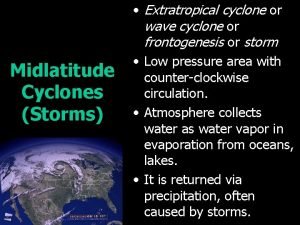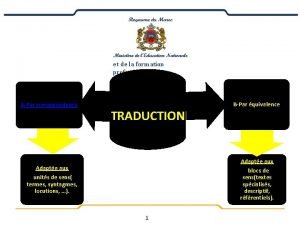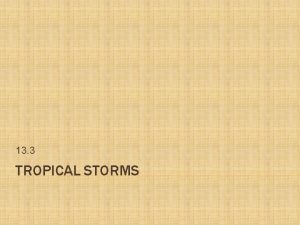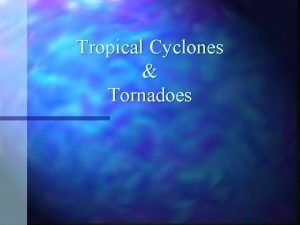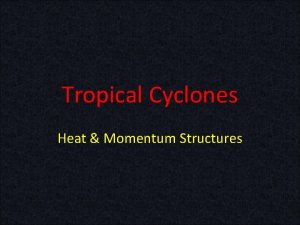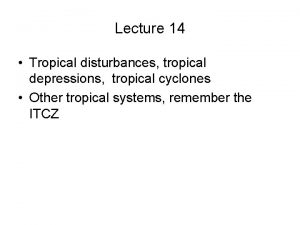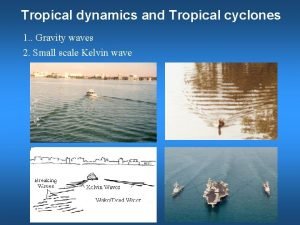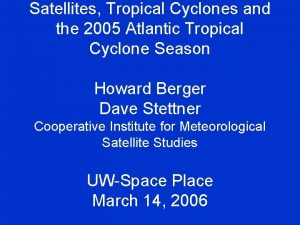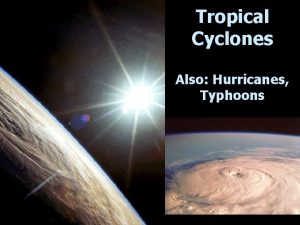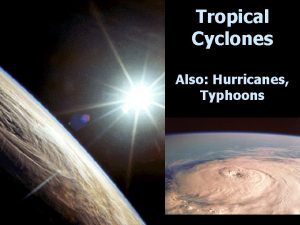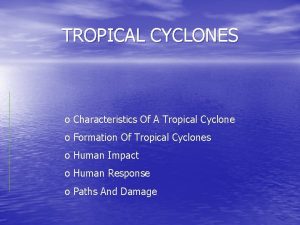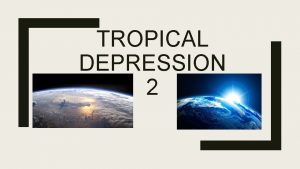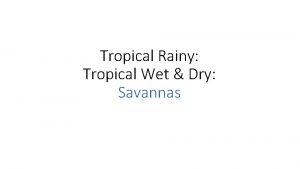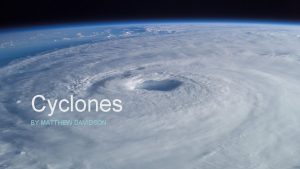Chap 5 5 Tropical cyclones TC terme gnrique


















- Slides: 18

Chap. 5. 5 Tropical cyclones (TC) (terme générique signifiant dépression tropicale) Source : d’après Chris Landsea et le site internet de la NOAA http: //www. nhc. noaa. gov • Tropical cyclone with maximum sustained winds of less than 17 m/s (34 kt, 39 mph) are called ‘tropical depression’ • Tropical cyclone reaching 17 m/s are called ‘ tropical storm’ and are baptized.

Chap. 5. 5 Tropical cyclone Dina, 22/01/2002 image infrarouge colorée. Source : Météo-France Dina, 22/01/2002 If winds reach 33 m/s (64 kt, 74 mph), tropical cyclones are called : • ‘hurricane’ (N. Atlantic, NE Pacific east of dateline, South Pacific east of 160 E) • ‘typhons’ (NW Pacific west of dateline) • ‘severe tropical cyclone’ (SW Pacific west of 160 E, SE Indian Ocean east of 90 E) • ‘severe cyclonic storm’ (N. Indian Ocean) • ‘tropical cyclone’ (SW Indian Ocean)

Chap. 5. 5 Tropical cyclone : OMM classification Sustained wind speed are used for classification of tropical cylones; Threshold are the same all over the world, but the mean of the wind is realized over a period of 1 mn over USA and their survey zones (Atlantic N. and Pacific N. ) and 10 mn elsewhere échelle Beaufort et vitesse du vent (kt) 7 B 8/9 B 34 10/11 B 64 48 Tropical depression storm 12 B Severe Tropical storm 115 91 Hurricane Severe Very Hurricane Severe Hurricane Baptism threshold (only lettre of Alphabet • This scale is used around the world except for hurricanes of N. Atlantic North. and NE Pacific where they use SAFFIR scale. • Each year, 85 Tropical storm occurred whose 9 over northern Atlantic

Chap. 5. 5 Tropical cyclone Which difference between extra-tropical cyclone and tropical cyclone ? Source : Merrill, 93 • Extra-tropical cyclone : storm system that primarly gets its energy from horizontal gradient temperature. They are called mid-latitudes or baroclinic storms and low pressure systems are associated with cold fronts, warm fronts, and occluded fronts • Tropical cyclones, in contrast, typically have little to no gradient horizontal temperature across the storm at the surface and winds are derived from release of energy due to cloud/rain formation from the warm moist air 5. 6. 2 : struct. hurricane

Chap. 5. 5 Tropical cyclone 6 conditions necessary for the development of tropical storms (Gray, 79) 3 thermodynamical conditions : 1. SST>26. 5° (80°F) over 50 m. at least (summer, early fall) 2. Atmosphere is conditionnaly unstable (at least, at the early stage of the TC); so no occurrence with trade inversion 3. Hu>70 % between 700 and 500 h. Pa 3 dynamical conditions : 4. Coriolis force; outside of 3 -5° latitude (usually between 5 and 25°) 5. A strong disturbance = weak low with cyclonic circulation 6. Very little vertical shear (surface easterlies and upper tropospheric easterlies) usually S<12 m/s between surface and upper troposphere

Chap. 5. 5 Tropical cyclone These 6 conditions necessary for initiation of tropical storm explain the spatial distribution Source : d’après Gray, 1979 No initiation • over land • inside the equatorial zone (5°N/5°S) • over S. Atl. and Pacific SE (no ITCZ and SST too cold) • why no initiation over Central Pacific ? Answer, next slide

Chap. 5. 5 Tropical cyclone Mean vertical shear between 850 and 200 h. Pa in august Source : d’après Gray, 1968 ‣ The strong vertical shear (20 -40 kt) over Central Pacific prevents initiation of Tropical Storm contents chap. 5

Chap. 5. 5 Tropical cyclone Annual frequency of Tropical storm Sources : Gray 68, Allard 84, Basher 95, Holland 84 a, Holland 84 b, Holland 84 c, Mc. Bride 81 a, Mc. Bride 82

Chap. 5. 5 Tropical storms over North Atlantic Source : D’après Atkinson, 1971. 9 per year

Chap. 5. 5 Tropical storms over Eastern North Pacific 17 per year Source : D’après Atkinson, 1971.

Chap. 5. 5 Tropical storms over Western North Pacific Source : D’après Atkinson, 1971. 27 per year

Chap. 5. 5 Tropical storms over Southwest Pacific Source : D’après Atkinson, 1971. 5 per year

Chap. 5. 5 Tropical storms over North Indian Ocean Source : D’après Atkinson, 1971. 4. 5 per year Why not TC in july -august while SST is the highest ?

Chap. 5. 5 Tropical storms over North Indian Ocean Mean vertical shear between 850 and 200 h. Pa in august Source : d’après Gray, 1968 ‣ strong vertical shear > 40 kt over North Indian Ocean in august (SW monsoon flow in surface, Tropical Easterly Jet at 200 h. Pa) prevents initiations of tropical storms

Chap. 5. 5 Tropical storms over Southwest Indian Ocean Source : D’après Atkinson, 1971. 13 per year

Chap. 5. 5 Tropical storms over Southeast Indian Ocean Source : D’après Atkinson, 1971. 10 per year

References (1) - Allard, R. A. , 1984 : ‘A climatology of the characteristics of tropical cyclones in the Northeast Pacific during the period of 1966 -1990’. Master of Science Thesis, Texas Tech. Univ. , Lubbock, TX, 106 p. -Atkinson, G. D. , 1971 : Forecaster’s guide to tropical meteorology. USAF Air Weather Service, Technical Report N° 240, 364 p. - Basher, R. E. and Zheng X. Z. , 1995 : Tropical cyclones in the Southwest Pacific : Spacial patterns and relationships to Southern Oscillation and sea surface temperature’. J. Climate, Vol. 8, p. 1249 -1260 - Gray, W. M. , 1968 : ‘Global view of the origin of tropical disturbances and storms’. Mon. Wea. Rev. , Vol. 96, p. 669 -700 - Gray, W. M. , 1979. Hurricanes : Their formation, structure and likely role in the tropical circulation. In ‘meteorology Over the Tropical Oceans’ (D. B. Shaw, ed. ), p. 151 -218. Royal Meteorological Society, London. - Holland, G. J. , 1984 a : ‘On the climatology and structure of tropical cyclones in the Australian/Southwest Pacific Region. I. Data and tropical storms. Austra. Meteor. Mag. , 32, p. 1 -16 -Holland, G. J. , 1984 b : ‘On the climatology and structure of tropical cyclones in the Australian/Southwest Pacific Region. II. Data and tropical storms. Austra. Meteor. Mag. , 32, p. 17 -32 -Holland, G. J. , 1984 c : ‘On the climatology and structure of tropical cyclones in the Australian/Southwest Pacific Region. III. Data and tropical storms. Austra. Meteor. Mag. , 32, p. 33 -46

References (2) -Mc. Bride, J. L. , 1981 a : ’observational analysis of tropical cyclone formation. Part I. Basis definition of data sets. J. Atmos. Sci. , Vol. 38, p. 1132 -1151 -Mc. Bride, J. L. and T. D. Keenan, 1982 : ‘Climatology of tropical cyclone genesis in the Australian region’. J. Climate. , Vol. 2, p. 13 -33 - Merrill, R. T. , 1993 : ‘Tropical Cyclone Structure’ –Chapter 2, Global Guide to Tropical Cyclone Forecasting, WMO/Tropical Cyclone- N° 560, Report N° TCP-31, World Meteorological Organization; Geneva, Switzerland
 Describe the distribution if tropical storms
Describe the distribution if tropical storms Chap chap slide
Chap chap slide Air masses and fronts
Air masses and fronts What are middle-latitude cyclones?
What are middle-latitude cyclones? Geography of bangladesh
Geography of bangladesh Extratropical cyclone
Extratropical cyclone Degré d'un monôme
Degré d'un monôme Poetiese terme
Poetiese terme Scuola ruzzante montegrotto
Scuola ruzzante montegrotto 3/4²
3/4² Minusklammer
Minusklammer Terme générique
Terme générique En terme de contenu
En terme de contenu Contrats à terme
Contrats à terme Terme temporel
Terme temporel Uccp lamezia terme
Uccp lamezia terme Gleichungen
Gleichungen Forme pseudo abortive
Forme pseudo abortive Terme monoréférentiel en arabe
Terme monoréférentiel en arabe
